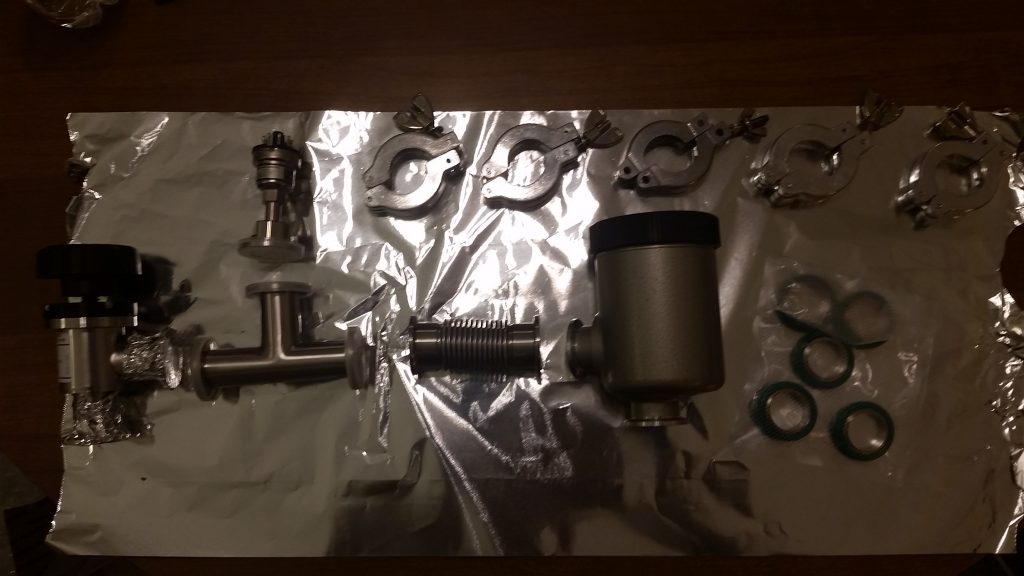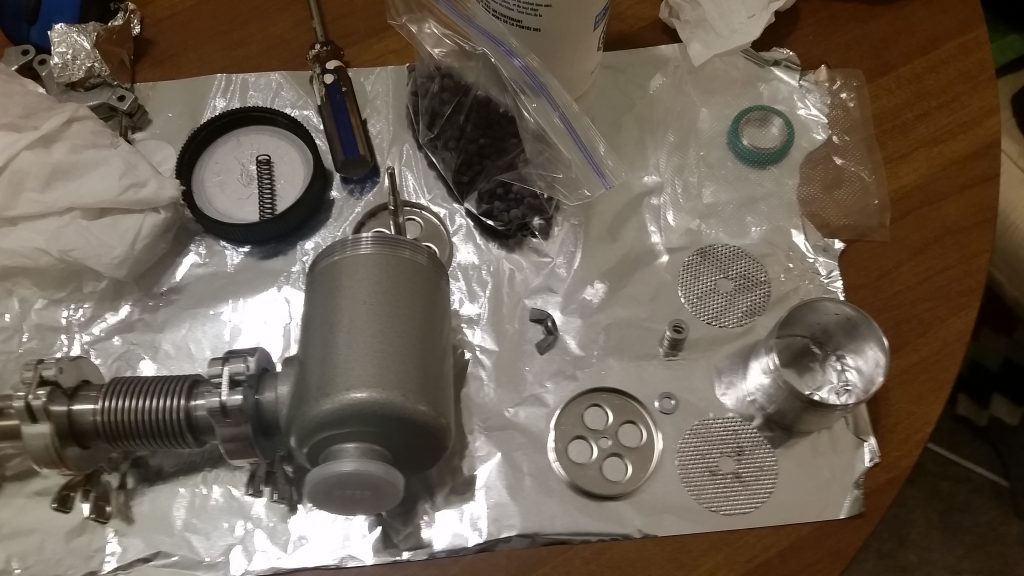Now that all of the major calculations have been completed, the system V4 design can finally start being pieced together. While the calculations are very enlightening, and required for planning the operational parameters of the system, actually building the system is where the real fun begins. It really is thrilling to see a high tech system slowly come together after months of planning, especially when it comes to life exactly as designed in CAD.
The first of the many subsystems to be built for the V4 design is the foreline, or roughing line. This is the low-vacuum line that will connect between the roughing pump and the backing inlet of the main high vacuum diffusion pump. The line includes several key components, consisting of a manual isolation valve, a thermocouple gauge sensor, and a molecular sieve foreline trap. Everything was selected with the KF25 flange standard, which matches the backing flange to the diffusion pump. KF hardware is also very cheap and widely available on eBay, and is very fast to implement, modular, and can be used to high vacuum levels around 10^-7 torr. Below are all of the parts for the roughing line, laid out on a sheet of clean, coating free aluminum foil. All of the parts were handled with clean nitrile gloves and thoroughly wiped down with 99.9% pure anhydrous isopropyl alcohol. While this is not really needed for the low vacuum side, it never hurts to get into the habit of proper practices and procedures for handling high vacuum equipment.
The foreline trap needed to be disassembled and cleaned prior to use. The trap material, some form of zeolite or alumina pellets, were already well contaminated and spent. They can be seen as small purple pellets in a plastic bag at the top of the picture below. The inside of the trap along with the stainless steel basket was thoroughly cleaned spotless with the alcohol. The trap was not refilled the trap yet with new adsorbent since it would be qualified later with the roughing line first and calibrated with the thermocouple gauge on a different oil-free pumping station, so opening up the container and absorbing moisture during qualification and calibration runs is unnecessary for now.
After all of the parts were cleaned, the roughing line was assembled. The side on the left with the 90 degree manual valve goes to the diffusion pump roughing inlet, while the side on the right with the foreline trap goes to the backing pump.
Finally, the adapters for the roughing pump were assembled to the pump. The pump inlet is a 3/8″ male flare fitting. Several adapters are needed to go from this to the KF25 to 1/2″ female NPT adapter. It was decided to keep the adapters equal to or larger than the original adapter on the pump to keep pumping speed high. A 3/8″ female flare to 1/2″ male flare adapter connects directly to the pump fitting, followed by a 1/2″ female flare to 1/2″ male NPT, which goes directly to the KF25 adapter. Teflon tape was used for the 1/2″ male NPT, but not for any of the flare fittings. The pump also includes an additional small 1/4″ male flare fitting off of the side of the main 3/8″ flare, which replaced the provided plastic cap with the appropriate 1/4″ brass flare cap.
Now that the foreline is complete, it can be qualified and the thermocouple gauge can be calibrated. The following link is provided to the page with the calibration data for this system: SYSTEM V4 PUMPDOWN AND SENSOR CALIBRATION DATA.





